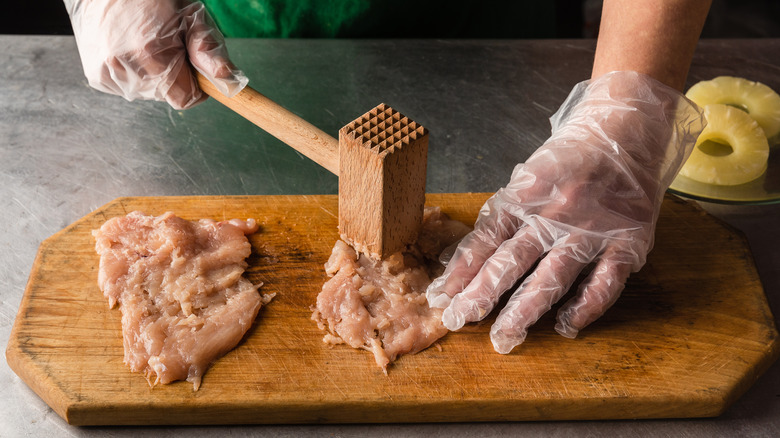Why You Should Poke Holes In Uncooked Chicken Breast
We may receive a commission on purchases made from links.
Chicken breast has gotten an unfair reputation in the culinary world. It's often associated with flavorless meal preps and only celebrated for its lean fat, high protein nutrition label. But a little prep goes a long way to getting a ton of flavor out of chicken breasts. In addition to proper seasoning, there's another trick to getting super flavorful chicken breasts — just pierce the breast with a fork a few times, or score it with a sharp knife.
This works for a few reasons, but one of the most important aspects is that it helps marinades penetrate deeper into the meat. Without scoring the breast, the mixture is likely to just sit on the surface, leaving you with a salty outside, seasoned exterior but a flavorless middle. That's why this simple trick leads to more flavorful, moist chicken breasts. Additionally, if you are working with skin-on cuts, the holes help to prevent skin shrinkage. And if you've ever enjoyed crispy chicken skin, you know you want to get as much of it as possible.
Treat marinated meat different than dry rubs
While the scored chicken breast method is great for marinated chicken, it's not always the right call. When you cook chicken in a skillet, for instance, you generally want to keep as many natural juices inside the breast as possible, and some believe that poking holes allows the liquid to cook out, leaving you with dried chicken. This may be true if you're doing a dry rub, also known as a dry brine, but in the case of a marinade, any lost liquid would be replaced by the solution.
To get the most out of your scored and marinated chicken, try roasting instead of baking it. One key difference in roasting is using a higher heat than baking, anything 400º Fahrenheit and above. This will allow the exterior of the breast to brown up beautifully, regardless of if it has skin or not. If it starts to brown too fast and the internal temperature hasn't reached its food safety standard, 165º Fahrenheit in the case of chicken breasts, cover it in foil to prevent burning. Be sure to allow the chicken to rest for a few minutes before cutting into it, as this period allows the natural juices and marinade to seep back into the meat.
Injecting your chicken with flavor may be a more effective way to poke holes in it
If you're all-in on the idea of chicken perforation, you may want to commit to buying a needle and syringe meant for this purpose. No, we're not talking about anything shady, since meat injectors are a valid way of applying flavoring agents below the surface of the meat. First, you'll prepare a tasty marinade (or a non-tasty one if flavorless chicken is your objective; although in that case, it would be easier to just leave it as-is). Add whatever spices and seasonings you like, then let them sit and infuse for as long as it takes to impart their flavor to the liquid. Before trying to load up the injector with marinade, though, you'll need to strain every last bit of solid matter out to prevent any large particles from clogging the needle.
If your meat injector comes with a selection of needles, a smaller size would be best suited for a chicken breast. Stick it onto the injector, dunk it in the marinade, then pull up the plunger to load. Now insert the needle horizontally into the breast to allow the liquid more room to spread. Pull the needle out, stick it into another spot, and repeat the process a few times until the chicken's all juiced up. After doing so, let the meat rest for a few hours in order for the internal marinade to do its thing.
Of course, hole poking isn't the only way to increase marinade penetration
While poking holes into your chicken breast will go a little way toward allowing the marinade to reach below the surface, still, the fact remains that marinades generally only affect the outer layer of the meat. To get the most bang for your buck (or marinade for your moolah, as it were), you can opt for increasing the amount of surface that comes into contact with the flavoring liquid.
One way to do this when working with a boneless chicken breast is to take a meat mallet (or a rolling pin, the bottom of a wine bottle, etc.) and whale on that chicken like it's Moby Dick and you're an avenging Ahab. This will not only tenderize the heck out of it but will flatten it out and make a larger area for the marinade to penetrate. Another, less bludgeon-y way, is to butterfly the chicken breast. Here you'll be using a sharp knife to slice almost all the way through the middle, then opening it up into two flatter, thinner, "wings."



